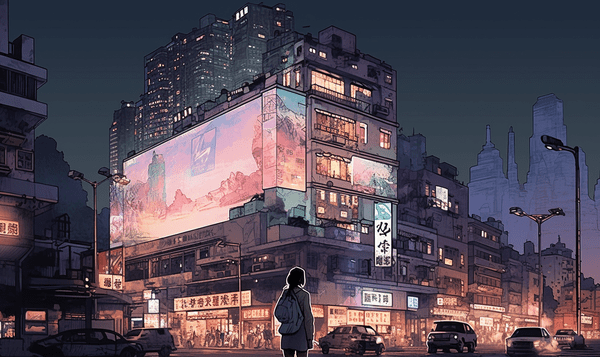In the labyrinth of advertising history, Out-of-Home (OOH) advertising stands like an ancient monolith, etching its story into the very walls that house our everyday lives. From the first lease of a billboard in 1867, a time when the world was draped in the smoke of the industrial revolution, to the neon-drenched present, OOH advertising has not just survived; it has thrived, morphing with the ages, mirroring human ingenuity.
Imagine the shock of our 19th-century billboard leasing pioneer upon seeing today’s OOH landscape, a $39.05 billion industry in 2023. Yet, in the grand carnival of advertising spend, OOH still plays the role of the underdog, a quaint relic in the digital juggernaut’s shadow. But, like the most enduring of tales, there’s more to OOH than meets the eye.
In the past, a billboard was static, a silent sentinel on a busy street. Today, it’s a chameleon, changing its colors with the pulse of the city. We’ve ushered in the era of digital panels, sprouting up in spaces as diverse as our own habitats – from the humdrum of bus shelters to the echoing halls of airports. This digital transformation has brought with it a treasure trove of data, turning every panel into a storyteller, narrating tales of demographics and consumer behaviors.
But here’s the rub: despite these leaps into the future, the heart of OOH still beats to an ancient drum. The sector, for all its digital façades, largely remains in the clasp of manual transactions. The dance between advertisers and agencies continues with the same steps, albeit with shinier shoes. Digital Out-of-Home (DOOH) advertising has dipped its toes into automation, but the vast ocean of OOH is yet to be explored.
The future of OOH, undeniably, is digital. In the US, DOOH ad spend is on a meteoric rise, projected to grow by double digits annually through 2027. In 2023, DOOH is reclaiming its pre-pandemic glory, accounting for 31.4% of total OOH ad dollars, surpassing 2019 levels. Yet, when the specter of inflation is factored in, DOOH still lags behind its pre-pandemic heights, a stark reminder of OOH’s shrinking slice of the total media budget pie.
Meanwhile, traditional OOH, the backbone of the industry, is not ready to bow out. In 2023 and 2024, traditional OOH ad spend is expected to increase by about 3%. The persistence of static billboards, especially outside metro areas where digital signage cannot justify its investment, ensures that about two-thirds of OOH ad dollars will remain in traditional placements for the foreseeable future.
Another fascinating development is the rise of in-store retail media as a significant player in the DOOH space. Retail environments are becoming hotbeds for digital advertising – at store shelves, end caps, cooler doors, and checkout aisles. By 2024, in-store retail media is expected to account for a tenth of US DOOH ad spending. This reflects the growing inventory of ad spaces in physical stores, a trend underscored by the fact that three-fourths of advertisers, as per a November 2022 Interactive Advertising Bureau (IAB) poll, are either running or considering in-store DOOH campaigns. Retail media sellers like GSTV, Cooler Screens, and Grocery TV are leading this charge, transforming retailers’ ability to influence not just sales but brand awareness and consideration at the point of purchase.
Now, let’s talk about the democratization of OOH. Think of social media advertising – a playground where businesses, big and small, frolic with equal glee. OOH, in contrast, is like an exclusive club, its doors open wide for the big spenders, while the small businesses peer through the windows. There’s a need for an upheaval, a revolution that brings the self-serve model of social media to the OOH world.
Imagine a world where any budding entrepreneur could, with a few clicks, plaster their dreams on a digital billboard, harnessing the same tools that once were the exclusive arsenal of the advertising giants. This isn’t just a flight of fancy; it’s the future knocking on the door.
The potential is enormous. While online advertising battles issues of ad fatigue and the ever-elusive consumer attention, OOH offers a respite. It’s the art gallery of the streets, where ads are not just tolerated but admired. Here, the message doesn’t interrupt; it integrates, becoming a part of the urban tapestry.
Yet, challenges abound. How do we reconcile the individualistic nature of OOH spaces with the need for standardization that automation demands? How do we marry the old with the new, the manual with the automated, the static with the dynamic? These are not just questions; they are the frontiers of the next advertising revolution.
As we stand at this crossroads, one can’t help but marvel at the journey OOH advertising has undertaken. From paper and paint to pixels and data streams, it has mirrored our own evolution. The future, undoubtedly, holds more changes, more transformations. And in this ever-changing landscape, OOH advertising, like an old bard, will continue to tell its story, one billboard at a time.




